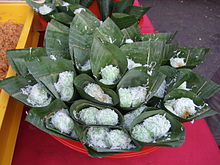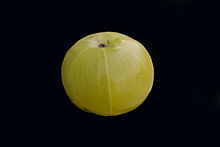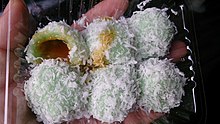Buah melaka (Kuih)
This article needs additional citations for verification. (July 2024) |
Buah melaka or Onde-onde in (Malaysian) refers to the traditional Kuih from Malacca[1], this Kuih is shaped like a Melaka fruit that is Indian gooseberry. It is famous in Malaysia, also spread to Singapore, Brunei, Sumatera and Sulawesi.
 Buah melaka or Onde-onde photo taken by Malaysian Chinese in Australia | |
| Alternative names |
(Malacca and Malaysia)
(Malaysia, Brunei, Singapore, Sumatra and Sulawesi)
(Singapore)
|
|---|---|
| Type | Kuih |
| Place of origin | Malacca[2] |
| Region or state | Malaysia[3], Singapore[4], Brunei, and Indonesia. |
| Created by | Malacca Malay |
| Main ingredients | glutinous rice flour, pandan, gula melaka or gula nise, grated coconut, salt |
| Variations | Royal blue buah melaka |
| Other information | Klepon, bua loi, mont lone yay baw, Khanom tom, tangyuan, modak |
History and Naming
[edit]This Kuih was already created before the colonial era, after the city of Malacca was opened by Parameswara, the melaka tree became the pride of the people of Melaka until today[2].


Buah melaka (Kuih) was inspired by the Melaka fruit tree which is (Phyllanthus emblica) a species from the Gooseberry family. This kuih is based on glutinous rice flour, pandan leaves, melaka sugar and grated coconut and salt. One of the cooking ingredients of the Melaka community is gula Melaka, this sugar has a high concentration in Malaysia compared to gula nise or gula kabung. That's why Buah melaka (Kuih) got its name from the appearance of melaka fruit and the combination of melaka sugar. This dessert is famous among Peranakan Chinese and Peranakan Indian in Malaysia which is Baba Nyonya[5] and Chetty,Melaka. In addition to being known as Buah melaka (Kuih), it is also called Onde-onde which comes from the Portuguese word Onde-oande meaning everywhere in dimana-mana[6]. It is possible that when the Portuguese arrived in Melaka City, they ate Buah melaka (Kuih) and found melaka trees everywhere, then they named it Onde-onde [citation needed].
In Singapore call Ondeh-ondeh [7] every word between e or the last word e they will add the letter H. While in Brunei call it Kuih pancit because when eaten the sugar will splash.
In Kelantan they call it Onde-onde or Kekohcar, they don't use melaka sugar, they have their own sugar which is nise sugar nise sugar which is the pride of the people of Kelantan.
In Sumatra and Sulawesi they also call it Onde-onde, they use red sugar or saka sugar. After the Portuguese arrived in Malacca, they went to Sumatra and Sulawesi, it is possible that Onde-onde was spread by the Portuguese army. The Melaka Sultanate was also very close to the Pasai Kingdom in Sumatra and the Maluku Sultanate in Sulawesi in the 15th to 17th centuries [citation needed].
There is a similar dish in Indonesia which is Klepon meaning animal ovary, the ingredients used are slightly different which is the addition of suji leaves, sweet potato flour and using Aren sugar which is the sugar of the Javanese community. The terms they use are very different from the words Buah melaka and Onde-onde which are physically real.
Buah melaka Recipe
[edit]Buah melaka recipes are easier than Klepon, Basic ingredients:
- Glutinous rice flour
- Pandan leaf
- Melaka sugar or nise sugar
- Grated coconut
- Salt
Grind: 15 pandan leaves and 3 cups of water.
Knead: Add 3 cups of glutinous rice flour, add 3 cups of pandan juice and knead until combined. Cut: Take gula melaka or gula nise cut into small cubes.
Rounding: Take a spoonful of kneading mixture and then flatten it and fill in diced pieces of nelaka sugar or nise sugar and then round it. Make until the mixture is used up.
Boiling: Boil 2 liters of water then boil the cake mix until it rises, which means it is cooked.
Blend: Take grated coconut and a teaspoon of salt then mix on a plate. Lift the cooked mixture and continue rolling it on the grated coconut.
Gallery
[edit]


See also
[edit]Reference
[edit]- ^ Walker, Kylie (18 September 2019). "The stirring story of how rich, sweet palm sugar is made". SBS Food. Retrieved 16 July 2024.
- ^ a b Shazlan Ahmad, Ahmad (7 October 2010). "Buah Melaka@Onde-onde Melaka's historical heritage". Sayang Melaka. Retrieved 11 July 2024.
- ^ Walker, Kylie (18 September 2019). "The stirring story of how rich, sweet palm sugar is made". SBS Food. Retrieved 16 July 2024.
- ^ "Singaporean Desserts with Gula Melaka: Ondeh Ondeh and Kueh Kosui". Asia Society. Retrieved Jan 3, 2024.
- ^ Ahmad, Shazlan (15 July 2024). "Makanan Baba Nyonya which Famous in Malacca". Malaysia Mall. Retrieved 2 April 2018.
- ^ Ahmad, Shazlan (15 July 2024). "Onde-Onde or Onde-oande comes from a Portuguese word". Itranslate. Retrieved 15 July 2024.
- ^ Walker, Kylie (18 September 2019). "The stirring story of how rich, sweet palm sugar is made". SBS Food. Retrieved 16 July 2024.
